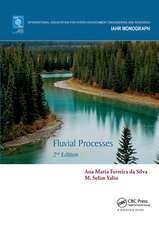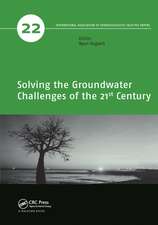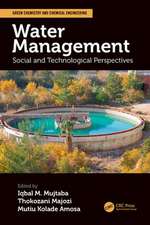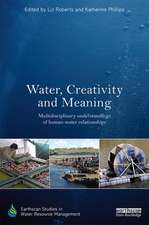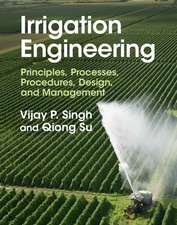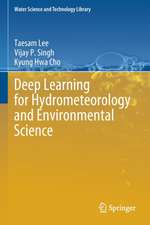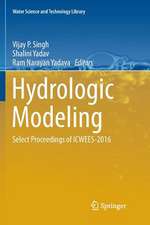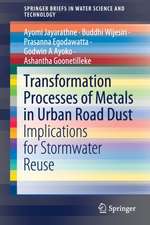Water Availability and Management in Mexico: Water Science and Technology Library, cartea 88
Editat de Elena María Otazo-Sánchez, Amado Enrique Navarro-Frómeta, Vijay P. Singhen Limba Engleză Paperback – 12 oct 2020
Water availability in Mexico is polarized, with abundant rainfall and large rivers in the south, and desert-like conditions in the north. The central region, which is the most industrialized, is overpopulated. Mexico City pours millions of cubic meters of “blackwater” into the northern valley daily and receives its clean water from the south. To address these unsustainable conditions, the world's 4th biggest water treatment plant went into operation in 2018.
The water infrastructure and governance must satisfy the demands of all sectors, including agricultural, urban, and economic activities. At the same time, water resources are affected by drought, and climate change puts constraints on the supply. As such, regulation and monitoring are important when it comes to adherence to agreed plans and priorities. The book is divided into four sections. 1: Water Availability discusses quantitative aspects, such as supply, methods of calculation, and fracking. 2: Water Quality highlights pollution risks and diagnosis of water resources. 3: Water Allocation examines the sectoral demands and vulnerability due to unsustainable irrigation. 4: Water Governance and Management focuses on laws, urban rules, national parks, planning, and integrated water resources management, among other topics.
The chapters include illustrative case studies in Mexico, such as basins, cities, reservoirs, and aquifers, water supply demand assessment, planning, and management.
| Toate formatele și edițiile | Preț | Express |
|---|---|---|
| Paperback (1) | 651.84 lei 6-8 săpt. | |
| Springer International Publishing – 12 oct 2020 | 651.84 lei 6-8 săpt. | |
| Hardback (1) | 588.15 lei 38-44 zile | |
| Springer International Publishing – 11 oct 2019 | 588.15 lei 38-44 zile |
Din seria Water Science and Technology Library
- 18%
 Preț: 950.96 lei
Preț: 950.96 lei - 15%
 Preț: 646.62 lei
Preț: 646.62 lei - 24%
 Preț: 796.92 lei
Preț: 796.92 lei - 18%
 Preț: 892.90 lei
Preț: 892.90 lei - 18%
 Preț: 953.65 lei
Preț: 953.65 lei -
 Preț: 459.43 lei
Preț: 459.43 lei - 18%
 Preț: 742.31 lei
Preț: 742.31 lei - 18%
 Preț: 1226.11 lei
Preț: 1226.11 lei - 18%
 Preț: 956.50 lei
Preț: 956.50 lei - 18%
 Preț: 1225.48 lei
Preț: 1225.48 lei - 18%
 Preț: 776.40 lei
Preț: 776.40 lei - 18%
 Preț: 1014.76 lei
Preț: 1014.76 lei - 18%
 Preț: 957.13 lei
Preț: 957.13 lei - 24%
 Preț: 744.68 lei
Preț: 744.68 lei - 18%
 Preț: 953.35 lei
Preț: 953.35 lei - 18%
 Preț: 1108.04 lei
Preț: 1108.04 lei - 18%
 Preț: 1121.65 lei
Preț: 1121.65 lei - 15%
 Preț: 644.63 lei
Preț: 644.63 lei - 18%
 Preț: 1116.71 lei
Preț: 1116.71 lei - 18%
 Preț: 731.91 lei
Preț: 731.91 lei - 24%
 Preț: 744.33 lei
Preț: 744.33 lei - 18%
 Preț: 894.46 lei
Preț: 894.46 lei - 18%
 Preț: 1020.74 lei
Preț: 1020.74 lei - 24%
 Preț: 945.42 lei
Preț: 945.42 lei -
 Preț: 553.51 lei
Preț: 553.51 lei - 24%
 Preț: 840.38 lei
Preț: 840.38 lei
Preț: 651.84 lei
Preț vechi: 766.87 lei
-15% Nou
Puncte Express: 978
Preț estimativ în valută:
124.77€ • 135.57$ • 104.87£
124.77€ • 135.57$ • 104.87£
Carte tipărită la comandă
Livrare economică 21 aprilie-05 mai
Preluare comenzi: 021 569.72.76
Specificații
ISBN-13: 9783030249649
ISBN-10: 3030249646
Pagini: 516
Ilustrații: X, 516 p. 155 illus., 108 illus. in color.
Dimensiuni: 155 x 235 mm
Greutate: 0.74 kg
Ediția:1st ed. 2020
Editura: Springer International Publishing
Colecția Springer
Seria Water Science and Technology Library
Locul publicării:Cham, Switzerland
ISBN-10: 3030249646
Pagini: 516
Ilustrații: X, 516 p. 155 illus., 108 illus. in color.
Dimensiuni: 155 x 235 mm
Greutate: 0.74 kg
Ediția:1st ed. 2020
Editura: Springer International Publishing
Colecția Springer
Seria Water Science and Technology Library
Locul publicării:Cham, Switzerland
Cuprins
1. Preface.- 2. Acknowledgment.- 3. Part I: Water Availability 1 Overview of the water condition in México.- 4. 2 Hydrological watersheads in Mexico. Division and legal definition.- 5. 3 The Groundwater condition in Mexico.- 6. 4 Runoff simulation under future climate change and uncertainty.- 7. 5 Hydraulic fracking of not conventional reservoirs in Mexico: The issue of water and waste control.- 8. Part II. Water Quality 6 Pollution in wastewater used for irrigation in the Mezquital Valley, México: case study.- 9. 7 Mining industry in Mexico: Recycling of flotation effluents to the process using anaerobic sulfate-reducing consortia in UASB reactors for the elimination dissolved metals.- 10. 8 Water body trophic state determinations. Case study Tecocomulco lagoon, Hidalgo, Mexico.- 11. 9 Water quality management for a sustainable supply. The diagnosis of the State of San Luis Potosi, Mexico.- 12. 10 The wetland of Cajititlán Lake severely deteriorated and in danger of dying out.- 13. 11 Water quality of the Nexapa River: a diagnosis.- 14. 12 Impacts on the groundwater quality that supplies the Puebla City by the effect of aquifer intensive exploitation.- 15. Part III: Water Allocation 13 Water resources allocation with supply and demand uncertainties.- 16. 14 An overview of aquaculture activity in Hidalgo state.- 17. 15 Drinking Water Services Situation by the Region in the State of Nuevo León, Mexico.- 18. 16 Population and tourism dynamics, its effects on the future demand for water. Case study from Los Cabos, Baja California Sur.- 19/ Part IV: Water Governance 17 Water governance in 16 Mexican National Parks.- 20. 18 Conflict in border condition: the dispute over the use of water in the Mexicali valley.- 21. 19 The institutional challenges of the municipalities of Zacatecas in the wastewater treatment.- 22. Part V: Water Management 20 The institutional challenges of the municipalities of Zacatecas in the wastewater treatment.- 23. 21 Improving environmental services of Candelaria River basin by restoring ecological connectivity.- 24. 22 Transdisciplinary approach to assessing socio-hydrological resilience in urban metropolitan environments: a Mexican perspective.- 25. 23 The 80% paradigm: An appointment with the sewage in Cuernavaca.
Notă biografică
Elena M. Otazo-Sanchez is a Full Professor in the Chemistry Department at Hidalgo State Autonomous University awarded as National Researcher Grade II by The Mexican National Council for Science and Technology (CONACYT). She received her B.S., M.S., and Ph.D. degrees in Chemistry at Havana University, where she was a full professor. Granted with a Patrimonial Cathedra by CONACYT and 21 national and international projects, invited professor at Havana University, Barcelona Autonomous University, Moskow State University, and Technischen Hochschule „Carl Schorlemmer“ Leuna-Merseburg. Member of the Mexican Environmental Sciences Association, leader and founder of the National Academic Network for Environmental Sciences and Sustainable Development, and member of the Network for Water Quality and Availability. She has led the interdisciplinary research project of the Hidalgo State Program for Climate Change Actions. Professor Otazo has graduated tents of BSc, MSc and Ph.D. pupils, published the results in hundreds of journals, conference papers, books and book chapters in water quality, heavy metal sensor ionophores, materials for water treatment, basins, groundwater, water resources, GHG emissions, and mitigation scenarios. For his scientific contributions, she has received national and international honors.
Amado Enrique Navarro Frómeta is a Full Time Professor in the Food Technology Department at the Technological University of Izúcar de Matamoros, México and recognized National Researcher Grade I by The Mexican National Council for Science and Technology (CONACYT). He received his B.S., degree in Chemistry at Havana University and his PhD degree in the Institute of Petroleum and Chemistry of Azerbaidzhan (at the present time the Petroleum Academy). He is member of the American and Cuban Chemical Societies, leader of the CONACYT Network for Water Quality and Availability. He has led various scientific Projects and has graduated 30 BSc students and13 MSc and Ph.D., published the results of his scientific research in 42 journal papers, 102 conference proceedings, 14 books and book chapters in petroleum, environmental and analytical chemistry. For his scientific contributions, he has received 6 awards.
Vijay P. Singh is a Distinguished Professor, a Regents Professor, and Caroline and William N. Lehrer Distinguished Chair in Water Engineering at Texas A&M University. He received his B.S., M.S., Ph.D. and D.Sc. degrees in engineering. He is a registered professional engineer, a registered professional hydrologist, and an Honorary diplomate in water resources engineering of the American Academy of Water Resources Engineers. Professor Singh has extensively published the results of an extraordinary range of his scientific pursuits. He has published hundreds of journal and tens of books and book chapters in hydrology, ground water, hydraulics, irrigation engineering, environmental engineering, and water resources. Forhis scientific contributions to the development and management of water resources and promoting the cause of their conservation and sustainable use, he has received more than 95 national and international awards and numerous honors, including three honorary doctorates. He is a Distinguished Member of ASCE, an Honorary Member of American Water Resources Association, and a fellow of EWRI, AWRA, IWRS, ISAE, IASWC and IE and holds membership in 11 international science/engineering academies. He has served as President and Senior Vice President of the American Institute of Hydrology (AIH) and is currently President-Elect of American Academy of Water Resources Engineers..
Amado Enrique Navarro Frómeta is a Full Time Professor in the Food Technology Department at the Technological University of Izúcar de Matamoros, México and recognized National Researcher Grade I by The Mexican National Council for Science and Technology (CONACYT). He received his B.S., degree in Chemistry at Havana University and his PhD degree in the Institute of Petroleum and Chemistry of Azerbaidzhan (at the present time the Petroleum Academy). He is member of the American and Cuban Chemical Societies, leader of the CONACYT Network for Water Quality and Availability. He has led various scientific Projects and has graduated 30 BSc students and13 MSc and Ph.D., published the results of his scientific research in 42 journal papers, 102 conference proceedings, 14 books and book chapters in petroleum, environmental and analytical chemistry. For his scientific contributions, he has received 6 awards.
Vijay P. Singh is a Distinguished Professor, a Regents Professor, and Caroline and William N. Lehrer Distinguished Chair in Water Engineering at Texas A&M University. He received his B.S., M.S., Ph.D. and D.Sc. degrees in engineering. He is a registered professional engineer, a registered professional hydrologist, and an Honorary diplomate in water resources engineering of the American Academy of Water Resources Engineers. Professor Singh has extensively published the results of an extraordinary range of his scientific pursuits. He has published hundreds of journal and tens of books and book chapters in hydrology, ground water, hydraulics, irrigation engineering, environmental engineering, and water resources. Forhis scientific contributions to the development and management of water resources and promoting the cause of their conservation and sustainable use, he has received more than 95 national and international awards and numerous honors, including three honorary doctorates. He is a Distinguished Member of ASCE, an Honorary Member of American Water Resources Association, and a fellow of EWRI, AWRA, IWRS, ISAE, IASWC and IE and holds membership in 11 international science/engineering academies. He has served as President and Senior Vice President of the American Institute of Hydrology (AIH) and is currently President-Elect of American Academy of Water Resources Engineers..
Textul de pe ultima copertă
This book presents several complex case studies related to water management and planning in the context of pollution, growing demands, and global climate change in Mexico, but which are also relevant for other countries in Latin America. These concerns are of critical importance for policymakers who are coping with multiple conflicting interests.
Water availability in Mexico is polarized, with abundant rainfall and large rivers in the south, and desert-like conditions in the north. The central region, which is the most industrialized, is overpopulated. Mexico City pours millions of cubic meters of “blackwater” into the northern valley daily and receives its clean water from the south. To address these unsustainable conditions, the world's 4th biggest water treatment plant went into operation in 2018.
The water infrastructure and governance must satisfy the demands of all sectors, including agricultural, urban, and economic activities. At the same time, water resources are affected by drought, and climate change puts constraints on the supply. As such, regulation and monitoring are important when it comes to adherence to agreed plans and priorities. The book is divided into four sections. 1: Water Availability discusses quantitative aspects, such as supply, methods of calculation, and fracking. 2: Water Quality highlights pollution risks and diagnosis of water resources. 3: Water Allocation examines the sectoral demands and vulnerability due to unsustainable irrigation. 4: Water Management and Governance focuses on laws, urban rules, national parks, planning, and integrated water resources management, among other topics.
The chapters include illustrative case studies in Mexico, such as basins, cities, reservoirs, and aquifers, water supply demand assessment, planning, and management.
Water availability in Mexico is polarized, with abundant rainfall and large rivers in the south, and desert-like conditions in the north. The central region, which is the most industrialized, is overpopulated. Mexico City pours millions of cubic meters of “blackwater” into the northern valley daily and receives its clean water from the south. To address these unsustainable conditions, the world's 4th biggest water treatment plant went into operation in 2018.
The water infrastructure and governance must satisfy the demands of all sectors, including agricultural, urban, and economic activities. At the same time, water resources are affected by drought, and climate change puts constraints on the supply. As such, regulation and monitoring are important when it comes to adherence to agreed plans and priorities. The book is divided into four sections. 1: Water Availability discusses quantitative aspects, such as supply, methods of calculation, and fracking. 2: Water Quality highlights pollution risks and diagnosis of water resources. 3: Water Allocation examines the sectoral demands and vulnerability due to unsustainable irrigation. 4: Water Management and Governance focuses on laws, urban rules, national parks, planning, and integrated water resources management, among other topics.
The chapters include illustrative case studies in Mexico, such as basins, cities, reservoirs, and aquifers, water supply demand assessment, planning, and management.
Caracteristici
Presents a fusion of social and technical approaches to analyzing current water problems Includes data and unpublished Mexican case studies, with similarities to other regions in Latin America Highlights inspiring lessons learned through the great diversity and variety of socio-environmental conditions Presents a comprehensive overview, including history, political administration, groundwater, and basins Discusses sustainable water management related to appropriate governance


